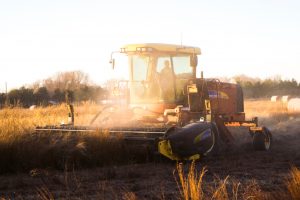For donors who actively engage in farming on a cash basis [1], significant tax savings can be found through donating grain directly to a favorite charity such as a public library, church, or university. Yes, you read that right. Grain. In short, the charities make money by selling the donated grain and the donors get tax deductions at a better rate than just cash donations.
Who Qualifies?
Keep in mind the tax benefits of gifting grain don’t apply to everyone, so not everyone who works in agriculture may qualify. As discussed more fully below, only cash basis farmers are able to reap these benefits.

Crop Share Landlords Not Eligible
There are two major kinds of farm leases: cash share leases and crop share leases (as well as hybrids of the two) [2]. A crop share landlord would not be eligible to receive the tax benefits discussed here. A crop share landlord’s share of crops is considered rental income and must be reported as such on the landlord’s tax return.
Tax Benefits
Tax Savings
Cash gifts to a charity are deductible if a donor itemizes deductions on Schedule A. Many farmers, however, take the standard deduction [3].
As many farmers take the standard deduction, no tax benefit is gained by making charitable gifts of cash. However, by directly donating grain to a charity organization the cash basis farmer can exclude the sale of the grain from income, which can result in a triple tax savings. The tax savings can include:
- Federal income tax savings (up to 39.6 percent)
- State income tax savings (up to 8.98 percent in Iowa)
- Self-employment tax savings (15.3 percent)
Expenses Related to Production
For most farm operators, the expenses related to the production of the donated grain are deductible on Schedule F [4]. The charitable donation of grain reduces the income that is reportable on Schedule F.
No Charitable Contribution Deduction
Donors of grain should not report the donation on Schedule A. There is no additional deduction allowed since the tax benefit comes from the deduction of production expenses and not reporting a sale on Schedule F.
Timing of Gift
Another great benefit of donating grain is that it doesn’t matter if the donation is made in the year of production or a later year. Gifts of grain can be donated from the current year or previous years’ harvests.
Fewer Forms
Yet another great benefit of donating grain: fewer forms! Generally speaking, if the total of your donated property is more than $500, you have to file an additional form with your return, Form 8283: Noncash Charitable Contributions. For property valued at more than $5,000, generally, you have to produce a qualified appraisal by a qualified appraiser.
However, with gifts of grain, as mentioned above, there is no charitable deduction taken. Therefore, the donor of grain doesn’t need to provide Form 8283 or a qualified appraisal. So, gifts of grain can be easier gifts than other types of property.

Cautionary Notes
Take note of these few considerations regarding prior sale commitments; physical delivery; giving up control; and storage, transportation, and risk.
No Prior Sale Commitment
To receive the tax benefits discussed in this article, farmers cannot sell the grain and then order the sales proceeds to be sent to the charity. The gift must be from unsold grain inventory with no prior sale commitment.
Physical Delivery
This is similar to the point made directly above regarding no prior sale commitment. The commodity should be put into the name of the charity when it is delivered to the elevator and a warehouse receipt should be issued in the name of the charity. For grain stored on the farm, the farmer should deliver to the charity a notarized letter of transfer.

Giving Up Control
The farmer must give up dominion and control over the grain and cannot offer any guidance as to when to sell the grain. The charity must direct the sale and the original sales invoice must list the charity as the seller.
Storage, Transportation, and Risk
After the transfer, the charity assumes the full costs of storage, transportation, and marketing, and bears completely the risk of any loss.
Use Professional Advisors
Donors should always consult with their professional tax and/or legal advisors to determine tax implications specific to their situation prior to making the gift.
Case Study of Tax Savings from Gift of Grain
Pat, a cash-basis grain farmer who takes the standard deduction every year, donates 1,000 bushels of corn to her favorite charity, a local hospital. Her cost of production is $2,000, and the proceeds from the sale of the corn by the hospital is $5,000.
Pat is entitled to deduct her $2,000 of production expenses on Schedule F. In addition, she will not be required to report the proceeds from the sale of the corn as income. Assuming that Pat is in the 25% federal and 8.98% Iowa tax bracket, the following are the tax savings that result when Pat reduces her taxable income by making a gift of the corn to a charity:
$1,250 Federal income tax ($5,000 x 25%)
$449 State income tax ($5,000 x 8.98%)
$765 Self-employment tax ($5,000 x 15.3%)
=$2,464 Tax savings
By donating the corn rather than selling it outright and making a cash gift, Pat saves $2,464 in taxes. In addition, she can still deduct the $2,000 of production expenses she incurred to grow the corn.
(Note: If Pat itemizes her deductions rather than claiming the standard deduction, her additional tax savings through making a gift of corn rather than cash would be limited to the savings on self-employment tax.)
Steps to Make a Gift of Grain to Your Favorite Charity

Be sure to consult with your tax preparer or financial advisor to determine the tax implications prior to making a charitable gift of grain. Staff of potential recipient charities are also usually more than happy to assist!
Contact the intended charity recipient of their intention to make a gift. (Some charities actually has forms specific to gifts of grain.)
- Donors will deliver the grain to the elevator and tell the elevator of the wish to transfer ownership of X number of bushels (or X fraction of the load) to the donee charity.
- Clients will need to request the elevator to issue a warehouse storage receipt in the name of the charity and send it to them. The donor should instruct the elevator not to sell the grain until they are contacted by the receiving charity.
- The receiving charity should be notified that the grain is at the elevator.The charity will then contact the elevator to direct the sale of the grain and will send the farmer (donor), an acknowledgment letter.
As you can see, it is very important for professional advisors and the recipient charity to be consulted before making the gift.
Every Iowan and every farm is unique. Be sure to consult with your own professional advisor. This article is not to be construed as legal advice, and is provided merely as general information.
Additional Information
[1] There are several methods of accounting for income. Farmers have been given an advantage in the Internal Revenue Code by being allowed to use the cash method of accounting. Most farmers choose the cash method because of the tax advantages. The cash method of accounting allows (many) farmers to claim the expenses of the current year’s crops while postponing the recognition of income. Under the cash method, all income is included in the year it is actually or constructively received. Farm business expenses are deductible in the year in which they are paid. For much more on farming, income issues, and the IRC, find a wealth of information here on IRS.gov.
[2] In a cash rent lease, generally, the tenant usually pays a fixed dollar amount in rent (either on a per acre or whole farm basis). These types of leases may be modified depending on crop yield (i.e., increase in good years and decrease in bad years). With cash rent leases, the landlord is not as involved in crop production, thereby giving the tenant more autonomy.
In a typical crop share lease, the landlord will share input costs (including but not limited to seed, fertilizer, and fuel), while the tenant provides all of the labor and remaining input costs. Once harvested, proceeds will be divided according to the agreement (which may range from, say, 25/75 to 50/50). With crop share leases, most often both parties share the risks.
Of course, there are hybrid arrangements. In any case, it’s important for both parties to make sure they have competent legal and tax counsel drafting the lease agreements.
[3] You can either claim the standard deduction or itemize your deductions—whichever lowers your taxes the most. The standard deduction is a fixed dollar amount that reduces the income you’re taxed on. Your standard deduction varies according to your filing status.
Three noteworthy items about the standard deduction:
- Standard deduction allows you a deduction even if you have no expenses that qualify for claiming itemized deductions.
- It eliminates the need to itemize deductions, like medical expenses and charitable donations.
- The standard deduction allows you to avoid keeping records and receipts of your expenses.
The benefit of itemizing is that it allows you to claim a larger deduction that the standard deduction. However, it requires you to complete a Schedule A attachment to your return and to maintain records of all your expenses.
Itemized deductions include a range of expenses that are not otherwise deductible. Common expenses include the mortgage interest you pay on up to two homes, your state and local income or sales taxes, property taxes, medical and dental expenses that exceed 7.5 percent of your adjusted gross income, and the charitable donations you make. Itemized deductions also include miscellaneous deductions such as work-related travel. Once you decide to itemize, you are eligible to claim all of them.
[4] If you earn a living as a self-employed farmer, then you most probably need to include a Schedule F attachment with your tax return to report your profit or loss for the year. The IRS defines “farmer” in a very broad sense and can apply whether you grow crops, raise livestock, or even breed fish!
In addition to money earned from selling crops and livestock, Schedule F also reports other types of farming income, such as any crop insurance payouts, including: federal disaster payments; money you earn through a farming cooperative; and payments you get from an agricultural program.
Cash basis farmers can deduct any cost incurred that’s an ordinary and necessary expense of farming on Schedule F to reduce the profit—or increase the loss—on which you’ll owe taxes. Some of the expenses farmers commonly deduct cover the cost of livestock and feed, seeds, fertilizer, wages paid to employees, interest paid during the year on farm-related loans, depreciation to recover a portion of equipment costs, utilities, and insurance premiums.









